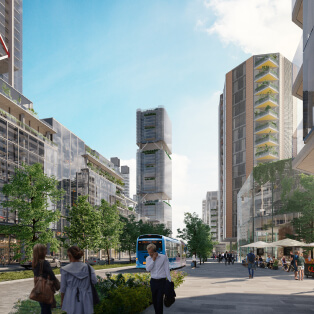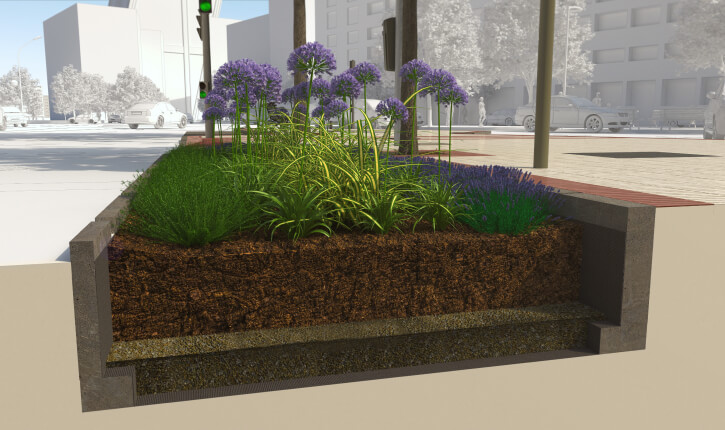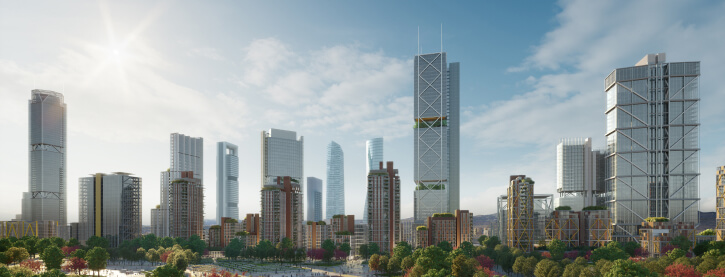










In order to take full advantage of the potential of Madrid Nuevo Norte as a way of accelerating the decarbonisation of the city, Madrid City Council has declared the Chamartín Central Business District— one of the four areas comprising the capital’s major urban transformation project— as a Low Carbon Demonstration Zone.

Madrid has set itself an ambitious target:
A major contributor towards that goal will be Madrid's major urban transformation project, Madrid Nuevo Norte, which is designed from the outset to be a benchmark for sustainability.
In fact, the specific urban regulations governing this project, which result from the Modification of the Madrid City Plan of Madrid, include measures related to energy efficiency and decarbonisation that outstrip current regulations on these matters.

The innovation in sustainability to which Madrid Nuevo Norte aspires needs novel initiatives, such as studies, research and pilot projects with a scientific approach, to get contrasted data and pave the way for many of these measures to be implemented, not only there but also in other developments and urban environments.
This ambitious sustainability strategy is not without its difficulties, both technical and regulatory, since many of the measures proposed are not provided for in the current legal framework and therefore require maximum coordination and public-private collaboration.
Additionally, difficulties arise from the scale and complexity of this urban development project, with infrastructures going beyond scope and requiring the technical and economic coordination of all stakeholders, both private owners and public administrations and companies.
Finally, the project’s essential economic viability must also be taken into account, a decisive factor in defining and managing the measures to be implemented.

Low Carbon Demonstration Zone (ADAC)
Given the complexity of the regulatory and technical obstacles to effective sustainable innovation, Madrid City Council has created the figure of Low Carbon Demonstration Zone, and the first area to have adopted this status is the Chamartín Central Business District urban project area of Madrid Nuevo Norte.
Madrid City Council, together with the landowners of the future central business district of Madrid Nuevo Norte, has created this special area dedicated to pursuing environmental excellence and helping the city of Madrid accelerate the achievement of its decarbonisation goals.
This tool analyses each technical, administrative and legal challenge and each possible obstacle to innovation, and coordinates the mechanisms required for regulatory change and technical and management models for the different initiatives under examination.
Its objective is to study the best techniques and strategies facilitating its implementation in order to spearhead the introduction of the most advanced sustainability measures, becoming at the same time an example for other cities and regions.
A strategic area has been chosen for the Madrid of the future, the Madrid Nuevo Norte Central Business District, where the most innovative urban solutions will meet a series of ambitious decarbonisation objectives.

These measures are included in an action plan, which will be reviewed and updated every three years, and whose initial objective is to reduce emissions in this future central business district by up to 70%.

A monitoring commission has been created, made up of representatives of the City Council, the Region of Madrid and the land owners in the area, whose purpose is to analyse compliance with the climate neutrality objectives of the demonstration area and, at the same time, to evaluate all regulatory, technical, economic and governance issues contributing to the achievement of these goals.

The Low Carbon Demonstration Zone. is at the forefront of international best practices in decarbonisation and provides practical evidence showing that public-private collaboration is key in the fight against climate change and in creating more sustainable, innovative and attractive cities for inhabitants.

The measures of the action plan are organised into four areas related to the construction of the city: the thermal demand of buildings and renewable energy, mobility, nature and the use of water. These are the main initiatives and challenges being faced:
Madrid Nuevo Norte prioritises sustainable mobility in a hyperconnected environment.
The project is designed on the basis of an extensive public transport network, rather than on a road structure, to encourage uptake by future inhabitants and users.
On the other hand, the dense, compact, mixed-use urban design significantly reduces the need for travel. Office, leisure and housing will be close and well connected, thus creating a vibrant and lively city.
Thanks to these measures, it is estimated that nearly 80% of trips in the Central Business District will be by sustainable means of transportation.
The model also integrates shared mobility and measures for sustainable last-mile logistics.

of trips in the Business Center will be made using sustainable modes of transportation.

Connected locally, regionally, nationally and internationally through Chamartín station. It enables around 5 million people to reach the area in less than an hour, complementing the idea of the “15-minute city” with that of a “45-minute region”.

Day-to-day needs will be less than a 15-minute walk or bike ride away

13 kilometers of segregated bike lanes
The commitment to the bicycle as a means of transportation comes to life in 13 kilometres of segregated cycle paths, connected to the Anillo Verde Ciclista and the Colmenar cycle path, a network of bicycle racks and a public bicycle sharing service.


As part of the Demonstration area, a pedestrian and cycling mobility study has been carried out to analyse the flows and functional needs of pedestrians to confirm that no problems arise in pedestrian and cycling flows in the urban space of the Central Business District.
The study covers the entire Central Business District and its interaction with the Central Park, transport interchange and Chamartín station, and down to the micro scale, by analysing street crossings, footpaths and interferences and interactions between pedestrians and vehicular traffic.
This study, not required by the regulations, seeks excellence in pedestrian and bicycle mobility, by focusing on it and guaranteeing a quality and fully functional public space.
Thanks to it, a system will be developed to halve the demand for drinking water in homes and offices by replacing it with reclaimed water, and sustainable urban drainage systems will be fitted for the natural management of rainwater in public spaces.

Urban sustainable drainage systems aim to reduce the volumen of water reaching the sanitation network by up to

Madrid Nuevo Norte seeks to implement sustainable urban drainage systems (SUDS) on a large scale in public spaces and in the plots to make soils permeable and recover the natural water cycle. The challenge is to apply these techniques in all areas of Madrid Nuevo Norte, one of Europe’s largest urban regeneration projects in Europe, at more than two million square metres.
Techniques such as porous sidewalks, rain gardens, drainage ditches and a greater presence of green areas all aim to retain, capture and infiltrate rainwater, thus reducing the volume reaching the sewage system by up to 71%.

This seeks to extend the use of reclaimed water to the domestic sphere
About 50% of the potable water used in an urban development project is due to toilet flushing.
Madrid Nuevo Norte aims to be the first development in our geographical environment to use reclaimed water for this purpose, for which the Low Carbon Demonstration Zone is working on the possibility of improving the production of reclaimed water at source, by acting at WWTPs to achieve a Urban A+- grade quality to allow such use.
The construction plans being drafted already accommodate the resulting reclaimed water demands, and a reclaimed water reservoir designed to meet and manage this possible new domestic use has been planned.
More conventional, but equally necessary measures to reduce water consumption are also under examination, such as the appropriate selection of plant species or the implementation of low consumption taps, as well as smart sensory irrigation control systems.


During times of heavy rainfall, runoff water carries a high degree of pollutants across roadway surfaces. For this reason, Madrid Nuevo Norte, in collaboration with Madrid City Council, has launched a pilot project to implement sustainable urban drainage systems (SUDS) in roadways and car parks, as well as pavements and parks in the new neighbourhoods.
Madrid Nuevo Norte will include 400,000 m² of green areas and will naturalise urban spaces, thus creating a more sustainable and liveable environment. In addition to taking the utmost care in the quality of landscaping parks, the selection of species and the connections with pre-existing green areas and protected natural spaces must consider the overall compatibility and coordination in their design with the complex network of infrastructures of the project.

Madrid Nuevo Norte will integrate green areas totaling up to

A linear network of parks is created as a real environmental promenade.
A green itinerary will be designed to be travelled on foot or by soft means of transport and that will reach Cuenca Alta del Manzanares Regional Park.

To the south of the M30, the environmental axis includes the great Central Park, a new destination on a metropolitan scale. A true urban forest in the heart of Central Business District
it will be built on the Chamartín train tracks, thus healing the historical fracture caused by the rail yards in this part of the city and creating a public space representative of the Madrid of the future.


As part of the initiatives of the Low Carbon Demonstration Zone, a study on biodiversity, both wildlife and flora, is underway to analyse the ecosystemic values in the urban spaces designed in Madrid Nuevo Norte.
Beyond the ornamental aspect and the social function of green infrastructure, the study analyses introduced plant species with a scientific approach, seeking that each selected species contributes specific functions from the point of view of urban ecology and biodiversity.

The technologies of the HVAC district networks will be renewable,

No gas: Urbanisation projects do not include gas supply infrastructure, in line with the objective of reducing the use of fossil fuels.
According to planning regulations, Madrid Nuevo Norte will comply with the following:
In addition to the urban planning regulations, the feasibility of implementing a district heating and cooling network in APE 05.31 Central Business District is being studied.

Mechanisms are under study to determine the possible implementation of HVAC networks at the district level.
Economy of scale
Superior efficiency is achieved by implementing a single shared network to provide HVAC to all buildings in the same neighbourhood.
Renewable
The technologies used will be 100% renewable.
Utilization of residual energy
They take advantage of the different service demands of offices and housing (e.g., the need to heat water in homes while nearby offices need to cool their indoor spaces in summer). To do so, they will use waste heat and cold to divert it to where it is needed through interconnected networks

Thermal storage in buildings
Buildings will store thermal energy in their structures, such as facades, pillars and beams, making them true energy stores.
Night hours
The system is a step towards overcoming the important challenge of how to store solar energy so that it can be used during nighttime hours.

Electric park
Energy for the city
Economic return
Mechanisms will be discussed to ensure that the owners of these vehicles benefit in exchange for the service they provide.


The implementation of district networks represents a technical, regulatory and management challenge which is being addressed by the Low Carbon Demonstration Zone.